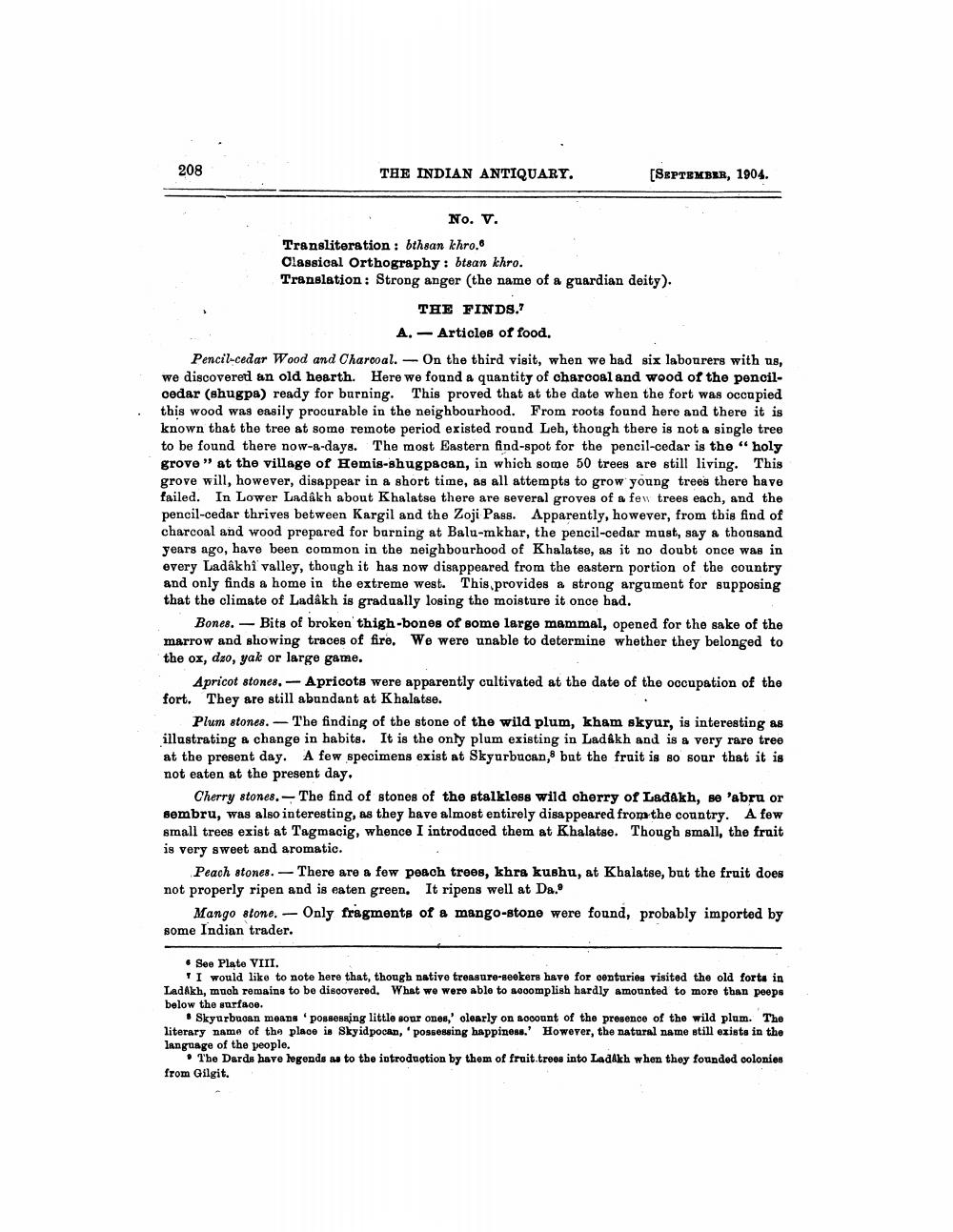________________
208
THE INDIAN ANTIQUARY.
[SEPTEMBER, 1904.
No. v. Transliteration : bthsan khro. Classical Orthography: btsan khro. Translation: Strong anger (the name of a guardian deity).
THE FINDS.?
A. - Articles of food, Pencil-cedar Wood and Charcoal. - On the third visit, when we had six labourers with us, we discovered an old hearth. Here we found a quantity of charcoal and wood of the pencilcedar (shugpa) ready for burning. This proved that at the date when the fort was occupied this wood was easily procurable in the neighbourhood. From roots found here and there it is known that the tree at some remote period existed round Leh, though there is not a single tree to be found there now-a-days. The most Eastern find-spot for the pencil-cedar is the "holy grove" at the village of Hemis-shugpacan, in which some 50 trees are still living. This grove will, however, disappear in a short time, as all attempts to grow young trees there have failed. In Lower Ladakh about Khalatse there are several groves of a few trees each, and the pencil-cedar thrives between Kargil and the Zoji Pass. Apparently, however, from this find of charcoal and wood prepared for burning at Balu-mkhar, the pencil-cedar must, say a thousand years ago, have been common in the neighbourhood of Khalatse, as it no doubt once was in every Ladakhi' valley, though it has now disappeared from the eastern portion of the country and only finds a home in the extreme west. This provides a strong argument for supposing that the climate of Ladakh is gradually losing the moisture it once bad.
Bones. - Bits of broken thigh-bones of some large mammal, opened for the sake of the marrow and showing traces of fire. We were unable to determine whether they belonged to the ox, dzo, yak or large game.
Apricot stones. - Apricots were apparently cultivated at the date of the occupation of the fort. They are still abundant at Khalatse.
Plum stones. The finding of the stone of the wild plum, kham skyur, is interesting as illustrating a change in habits. It is the only plum existing in Ladakh and is a very rare tree at the present day. A few specimens exist at Skyarbucan, but the fruit is so sour that it is not eaten at the present day.
Cherry stones. The find of stones of the stalkless wild cherry of Ladakh, se 'abru or sembru, was also interesting, as they have almost entirely disappeared from the country. A few small trees exist at Tagmacig, whence I introdaced them at Khalatse. Though small, the fruit is very sweet and aromatic.
Peach stones. There are a few peach trees, kura kushu, at Khalatse, but the fruit does not properly ripen and is eaten green. It ripens well at Da.
Mango stone. - Only fragments of a mango-stone were found, probably imported by some Indian trader.
• See Plate VIII.
"I would like to note here that, though native treasure-seekers have for conturies visited the old forts in Ladakh, much remains to be discovered. What we were able to accomplish hardly amounted to more than peeps below the surface.
Skyurbugan means 'possessing little sonr ones,' olearly on socount of the presence of the wild plum. The literary name of the place is Skyid pocan,' possessing happiness. However, the natural name still exists in the language of the people.
• The Dards have legends as to the introduction by them of fruit trees into Laddkh when they founded colonies from Gilgit.




